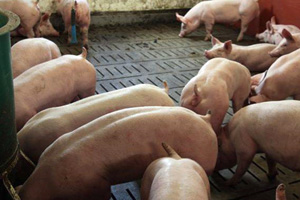MSU research: Curtail pig fighting on swine farms

Fighting, a common behavior seen in groups of pigs, poses serious risks such as injury, infection, stunted growth and failed pregnancies on pork farms. An MSU AgBioResearch scientist is leading a multidisciplinary effort to find ways to curb fighting and enhance swine productivity and quality of life with a nearly $750,000 grant from the US Department of Agriculture.
Janice Siegford, an assistant professor of animal science, said pigs raised in agriculture are grouped together by age, weight and sex, which often leads to conflict when pigs try to establish social hierarchies. In wild pigs, which live in small, matrilineal family groups, fighting typically occurs only to settle disputes between rival dominant animals in the group.
“What we’re essentially trying to do is figure out whether these aggressive social behaviors in pigs on farms are heritable and if we can select genes through breeding that show improved behavior and less fighting,” Siegford said.
Pigs are most likely to fight when first put into groups, but the study will examine if the aggressive behavior changes over time. The research team will observe eight groups of 140 pigs each from birth to the time they would either be sent to market or separated for breeding.
“During the first 72 hours after meeting, the pigs can literally beat the snot out of one another,” Siegford said. “There’s a lot of biting and smacking heads together, and the bigger the pig, the harder it bites and the more serious the injuries.”
The researchers will collect 24 hours of video when the pigs are introduced and another 24 hours three weeks later. The team will analyze the behavior that each pig displays and count the incidence of injuries. They will also compare the behaviors of each pig with genetic samples to determine whether heredity plays a role in aggressive tendencies.
As concern over the health and care of animals mounts, the World Trade Organization and animal health organizations are developing animal welfare standards for farms. Siegford said her ultimate goal is to give pork producers in the United States the tools they need to meet these new standards while remaining economically viable. She plans to host workshops with farmers to discuss the results.
In addition to the USDA three-year grant, Siegford’s work is supported by funding from the MSU Rackham Foundation and the National Pork Board.
Source: Michigan State University (MSU)











